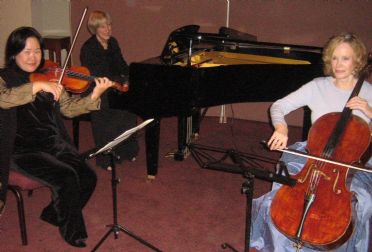|
Symphony
FROM THE NEW WORLD TO THE OLD WORLD
by Peter Lert
Saturday, June 14, 2025
Chamber
MC2 DUO RECITAL CLOSES 222'S SEASON
by Terry McNeill
Saturday, June 14, 2025
Choral and Vocal
CANTIAMO SONOMA'S LUSCIOUS A CAPELLA SINGING IN SEASON ENDING CONCERT
by Pamela Hicks Gailey
Sunday, June 8, 2025
Symphony
SRS SEASON ENDS WITH RESOUNDING TA-TA-TA-BANG
by Terry McNeill
Sunday, June 1, 2025
Symphony
YOUTHFUL VIRTUOSITY ON DISPLAY AT USO'S MAY CONCERTS
by Peter Lert
Saturday, May 17, 2025
Symphony
MYSTICAL PLANETS AND LIVELY GERSHWIN ORTIZ AT FINAL SRS CONCERT
by Peter Lert
Sunday, May 4, 2025
Symphony
VSO'S CONCERT MUSIC OF TIME, MUSIC OF PLACE
by Peter Lert
Sunday, April 27, 2025
VOCAL ELEGANCE AND FIRE AT THE 222'S RECITAL APRIL 26
by Pamela Hicks Gailey
Saturday, April 26, 2025
CANTIAMO SONOMA SINGS AN INSPIRED GOOD FRIDAY MOZART REQUIEM CONCERT
by Pamela Hicks Gailey
Friday, April 18, 2025
DRAMATIC SHOSTAKOVICH SYMPHONY CLOSES PHILHARMONIC'S 25TH SEASON
by Terry McNeill
Sunday, April 13, 2025
|
 |
 I Solisti di Sonoma Playing Beethoven's Trio Jan. 14 in Healdsburg |
I SOLISTI DI SONOMA BEGINS THREE-CONCERT SERIES TO BENEFIT APSC IN HEALDSBURG CHURCH
by Terry McNeill
Friday, January 14, 2011
Chamber music was launched in grand style for the 2011 year Jan. 14 when the American Philharmonic Sonoma County presented the first of three small group concerts featuring artists associated with the APSC.
Designed as a fund raiser to cover costs incurred from the historic tour to China, the concert at the Healdsburg Community Church preceded events at Santa Rosa’s Glaser Center and the charming Jacuzzi Family Vineyards in Sonoma. The performers, named “I Solisti di Sonoma,” donated their artistry and gave a small audience of 23 a rich program, albeit from ever-popular composers.
Beethoven’s Piano Trio in E-Flat Major, Op. 1, opened the program with pianist Marilyn Thompson’s pearly scales taking charge. The piece, from 1793, gets away from the keyboard-dominant trios of Haydn and Mozart and in the acoustically dead church space Margaret Moores’ cello carried all evening with a rich sonority. The long Allegro found violinist Pam Otsuka wrestling with pitch problems and a thin tone that settled down in the Adagio cantabile, highlighted by soft Alberti bass figures in the piano and ending in two lovely string pizzicato chords and two soft answering chords from Ms. Thompson.
The concluding lilting Scherzo and Presto finale unfolded smoothly, the Presto chords from the piano on the octave seeming to signal the quick tempo and instrumental interplay. Ensemble here was the best of the evening.
Prior to Schumann’s Adagio and Allegro for Cello and Piano, Op, 70, APSC Board Chair Brian Lloyd announced the dates of the forthcoming concerts and related stories of the historic APSC tour of China that ended Jan. 6. Mr. Lloyd, a cellist, then discussed the role of his instrument in the lives of the Schumanns and Brahms, and speculated that Brahms may have written (like Robert Schumann) a cello concerto, but destroyed it.
Ms. Moores (playing from score) and Ms. Thompson gave an ardent reading of the ten-minute Schumann work from 1849, a piece heard often with the French horn. Here again the cello carried well, the tempos judicious and the ritards in the Adagio broad and never breaking the musical line. The rondo form Allegro had lots of breathing room and the cellist lacked clarity and coordination with the piano only when fast articulation was needed on the fingerboard.
The program concluded with Brahms’ Sonata for Cello in E Minor, Op. 38, written in 1865. In the noble opening theme the low frequencies of the cello were opulent, sporadically overcoming the sound from a less-than-professional church piano. It’s not often that the cello outguns the piano and a virtuoso such as Ms. Thompson, and this imbalance also happened during the closing E Minor movement. The dance-like rhythms of the Allegretto quasi Menuetto were played with gusto, and during each movement Ms. Moores’ pitch was dead on, and the deep note in the cello ending the first movement was haunting.
Additional “I Solisti di Sonoma” concerts are planned for the spring season.
|

